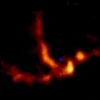| Meetings for the new SWARM data pipeline and CASA for SMA data reduction | ||||
|
Try out the SWARM2CASA pipeline for SMA users
A series of special meetings concerning SMA SWARM data.
int antennaNumber;
...
int inhid ; /* integration id # */
int ints ; /* integration # */
double dhrs ; /* hrs from ref_time */
double ha ; /* hour angle */
double lst ; /* lst */
...
double tsys ;
double tsys_rx2 ;
double ambient_load_temperature ;
| ||||




